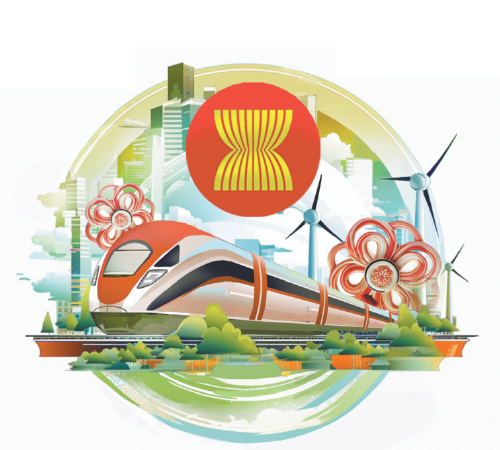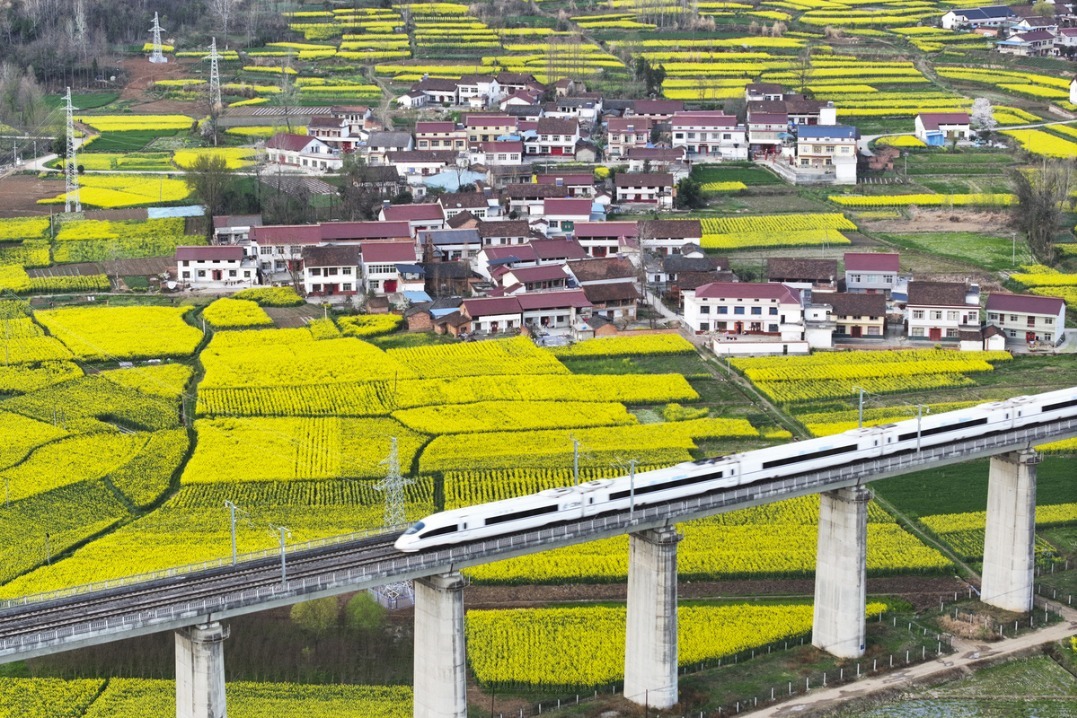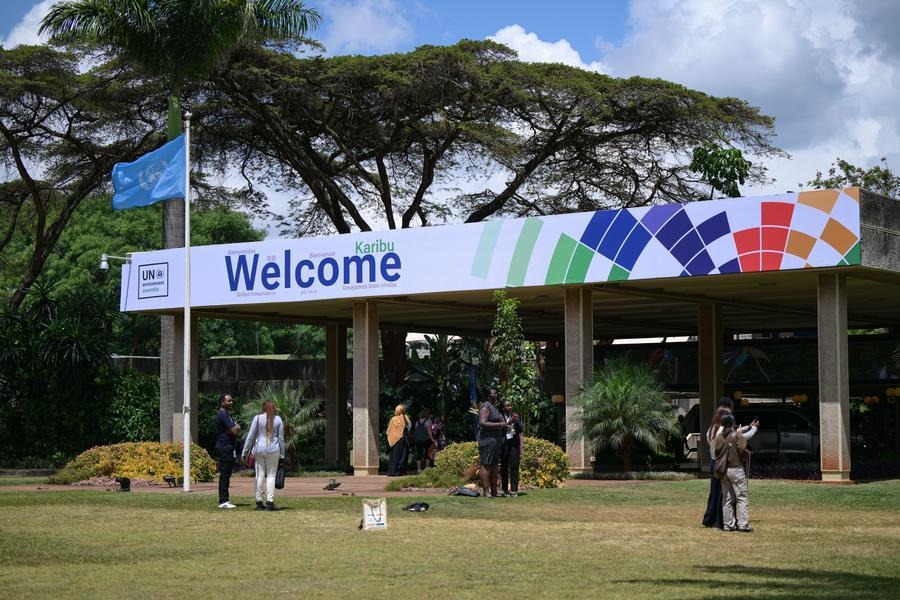Experts share views on China-ASEAN relations
China Daily | Updated: 2023-09-04 07:54

Editor's note: The China-ASEAN relations enjoy sound and steady growth. China and ASEAN countries have pulled together with solidarity in this trying time, and the China-ASEAN relationship shows a sound momentum of all-round development. The two sides have safeguarded stability and sustained economic growth in the region, and established a path of win-win cooperation. Three experts share their views on the issue with China Daily.
The 43rd ASEAN Summit, to be held in Jakarta on Sept 5-7, will signal the beginning of a period of hectic activity in the Asia-Pacific region. Right after the ASEAN Summit and related leaders' meetings, several leaders attending the meeting are expected to fly to India to attend the G20 Summit in New Delhi from Sept 8 to 10.
The Association of Southeast Asian Nations has come a long way since it came into being in 1967 and held its first summit in 1976. Interestingly, the first ASEAN Summit, too, was held in Indonesia (Bali to be precise). Indonesia is currently the chair of the 10-member ASEAN that includes Brunei, Cambodia, Indonesia, Laos, Malaysia, Myanmar, the Philippines, Singapore, Thailand and Vietnam. In fact, Indonesia, the largest and most populous country in Southeast Asia, has always played a prominent role in providing leadership to ASEAN.
Indonesia's prominent role in not just regional affairs, but also international affairs, is evident from its successful handling of G20 affairs as the group's chair in 2022. Indeed, Indonesia's experience of handling the diplomatic challenges of being the G20 chair will help it to successfully chair the ASEAN Summit.
ASEAN summits have significantly focused on the relationship between ASEAN and its strategic partners, the most important being those countries with whom ASEAN has established comprehensive strategic partnerships. They include Australia, China, India and the United States. Among these strategic partners of Indonesia, China has a special role. China is not only a comprehensive strategic partner of ASEAN, but also a part of the ASEAN+3 regional cooperation mechanism which also includes Japan and the Republic of Korea. China is also engaged with ASEAN through the East Asia Summit mechanism.
China's engagement with ASEAN is deep and varied, and it is most prominent on the economic side. China's organic economic linkages with ASEAN member states have resulted in China's economic performance having a strong impact on ASEAN's economic prospects.
Of late, China is experiencing relatively slow economic growth. After growing by only 3.0 percent last year, the Chinese economy, as forecast by the International Monetary Fund, is expected to grow by 5.2 percent and 4.5 percent in 2023 and 2024. This relatively low rate of China's GDP growth has also impacted developing Asia. ASEAN, which is an important part of developing Asia, is expected to grow by 5.3 percent in 2023 and 5.0 percent in 2024. Clearly, China's relatively slow growth rate has impacted the growth of developing Asia and ASEAN.
Over the years, several industrial supply chains have emerged in the Asia-Pacific, integrating the economies of China and many ASEAN member states. Many of these supply chains were disrupted, even ruptured during the COVID-19 pandemic. Many of the regional supply chains, in the meantime, had begun reconfiguring, creating new production network specifications among China, ASEAN and the rest of the world.
The pandemic also created new complications for regional geopolitics. The Sino-US competition has intensified, and is particularly manifesting in uneasy developments across the Taiwan Strait. The ASEAN economies, many of which are US defense partners and/or security allies, are finding it difficult to balance their relations between Beijing and Washington.
Complications have arisen also because the Russia-Ukraine conflict has dragged on for more than one and a half years. In fact, different ASEAN members have taken different positions on the conflict, with some of them being at variance with that of China. This, too, is impacting China's relations with ASEAN.
The final challenge to deepening cooperation between China and ASEAN arises from the struggles that are manifesting in critical areas such as climate change and the digital economy. Both China and ASEAN are facing the downsides of climate change. However, to jointly fight climate change, they need to establish or deepen cooperation across a large range of cross-border industrial rules and regulations, over which there might be disagreements.
Regional digital regulations, too, have given rise to problems. With digital trade becoming extremely significant, digital regulations have become critical to the overall prospects of trade and economic development for China and ASEAN. Both climate change and digital economy rules have political implications as well, in terms of the security issues they comprise, and are bound to impact mutual discussions.
Given their long history of engagement, China and ASEAN must closely reflect on various aspects of their relationship to ensure their trade and economic exchanges yield more mutual benefits in the future amid an increasingly complicated world.
The author is a senior research fellow and research lead (trade and economics) in the Institute of South Asian Studies, National University of Singapore.
The views don't necessarily reflect those of China Daily.
BRI has helped boost partners' growth in Southeast Asia
By CHANG CHAK YAN
Many accusations have been leveled against the Belt and Road Initiative since it was proposed by President Xi Jinping in 2013. The most common among them are: the initiative is a "debt trap" for developing countries and a form of "new colonialism", and it causes environmental destruction.
However, the attitude of the Association of Southeast Asian Nations toward the Belt and Road Initiative shows the accusations are simply baseless. ASEAN and its member states have been important Belt and Road partners since 2013, and the sheer number of projects completed and under construction under the initiative's framework shows the benefits have been mutual.
For example, a high-speed railway has been built in Laos. The about 142-kilometer-long Bandung-Jakarta high-speed railway in Indonesia was completed this year. The East Coast Rail Link (ECRL) is a 665 km standard gauge double-track railway link infrastructure project in Malaysia. And the massive Malacca Port project was launched two years ago which, after completion, would help ease the burden of the ever-busy Singapore port.
In Myanmar, Belt and Road projects including high-speed railways, highways and dams were launched in 2021. These infrastructure facilities will not only facilitate the movement of goods from and to China's landlocked Yunnan and Guizhou provinces and the Xinjiang Uygur autonomous region, but also bring immense benefits for Myanmar.
Thailand, Cambodia and Vietnam are partnering the Belt and Road Initiative in various ways including the building of railways and highways. Singapore's status is vital for the initiative, especially in investment, environmental protection, finance and legal services. And despite being a relatively small country, Brunei is an important player in the fields of finance and oil. Therefore, it is a valuable partner of the initiative.
In case of the Philippines, the development of Belt and Road projects has been slow, yet China is the top trading partner of the Philippines. Former Philippine president Rodrigo Duterte was in favor of joining the Belt and Road Initiative. But after Ferdinand Marcos Jr won the presidential election in May 2022, the initiative couldn't make headway in the Philippines, mainly because he decided to revive the military agreement with the United States and has again intensified tensions over China's Ren'ai Jiao, or Ren'ai Reef. Overall Sino-Philippine ties suffered setback when the Philippines allowed the US military to rebuild naval bases on its soil with the aim of containing China's rise.
Nevertheless, the Belt and Road Initiative has made many remarkable achievements. First, Belt and Road projects have facilitated economic growth and social development in many countries. Railways, roads and ports have improved transportation, and form the backbone of growth, for they connect cities with towns and rural areas, even remote villages, expediting the movement of products, including agricultural produce, and thus enlarge markets, reduce unemployment and promote education, especially in the countryside.
Second, Belt and Road projects have helped expand many countries' foreign trade thanks to the construction and improvement of ports, airports and highways. This is most evident in countries such as Laos, Cambodia, Myanmar, Malaysia and Indonesia. Such projects have also helped ASEAN to become China's largest trading partner.
Third, the initiative has also helped restore political stability in some countries. By building and improving infrastructure under the Belt and Road framework, some countries have expedited economic development, creating huge numbers of jobs and reducing unemployment, which in turn have reduced public anger and blunted the opposition's attack against the government of the day.
Fourth, the Belt and Road Initiative has consolidated the centrality of ASEAN in the Asia-Pacific region, by helping promote long-term development in ASEAN member states through Chinese investments and trade. Only economic stability can ensure political stability. And for that, ASEAN should maintain its politically neutral stance and oppose outside interference in the region's affairs.
And fifth, coming back to the "China threat" theory that the US and its allies have been spreading, the strong relationship ASEAN and China have built over the past few decades shows that the ASEAN members are against the US' divisive strategy. The US has failed to lure the Southeast Asian countries to join its "Indo-Pacific strategy", which is aimed at suppressing China, because they know they tend to benefit from their economic and trade relations with China.
As Singapore Prime Minister Lee Hsien Loong has said, ASEAN as a whole cannot survive without trade with China.
Unhappy with this fact, US presidents have skipped the ASEAN summits. Former president Donald Trump was the first to do so. Incumbent President Joe Biden has decided to follow in his footsteps, and skip the Sept 5-7 ASEAN Summit in Jakarta.
To quote Lee Hsien Loong again, ASEAN cannot afford to take sides in the Sino-US confrontation. As a result, the "China threat" theory has no takers in Southeast Asia.
The author is the dean of Taima Journalism and Information Academy, Malaysia.
The views don't necessarily represent those of China Daily.
Indonesian development to offer more chances for Chinese investment
By Cyril Pereira
Fifty-six years on, a mature ASEAN, now with 10 member states, including Vietnam, Cambodia, Laos, Myanmar and Brunei, focuses on the free movement of goods within the bloc. Tariffs are set at zero and non-tariff barriers are being steadily lifted. That member states have enjoyed the peace dividend is evident from the political stability and economic growth in the region.
The 43rd ASEAN Summit, to be held in Jakarta on Sept 5-7, will see the association putting emphasis on positioning itself as a major regional player with huge economic growth and investment potential. It could become the new engine for global growth as China rises up the industrial ladder thanks to its pursuit of sustainable, technology-driven development.
Whereas previous ASEAN summits dealt mainly with intrabloc matters, the 43rd summit is likely to focus on external relationships, such as its relations with Asia-Pacific countries like Canada, Australia, New Zealand, India and China, for security, investment and market access purposes.
ASEAN member states have a combined population of 670 million and GDP of $3.7 trillion. As an economic bloc, its economic growth rate is expected to be higher than that of Japan and the Republic of Korea, not to mention the United States and the European Union, for the next decade.
As a matter of fact, due to its centrality in the Asia-Pacific economy, ASEAN is carving its space on the global stage. For instance, in November 2020, China, Japan, the ROK, Australia and New Zealand joined the 10 ASEAN members to form the Regional Comprehensive Economic Partnership, the world's largest free trade agreement. The RCEP covers one-third of the world's population and accounts for 30 percent of global GDP, and it is the first FTA Japan has signed which also includes China and the ROK.
Thanks to the RCEP, about 65 percent of the goods traded among the 15 members are tariff-free, and in about 20 years 90 percent of them will carry zero tariff. This has facilitated the unhindered flow of raw materials and finished goods in the region, which will prompt China and Western economies to increase their investments in ASEAN economies.
What about road, rail and sea transport infrastructure within and across ASEAN member states which is needed to transform the policies into tangible benefits? Intra-ASEAN trade remains low at only 21 percent, perhaps because cross-border freight has become costlier due to logistical inefficiency and non-standardized regulations.
Amid all this, Indonesian President Joko Widodo has announced a plan to shift the country's capital from Jakarta to Kalimantan in Borneo, which requires the construction and development of roads, railways, buildings and a 5G network in the pristine rainforest province. It will be a greenfield site complete with smart city technology and sustainability. Nusantara (as the new capital has been named) would cost $32.5 billion to build.
In addition, Widodo plans to build 100"smart cities" across Indonesia by 2045. The latest digital technology, artificial intelligence, the internet of things, big data, waste recycling facilities, renewable energy generation and quality of life planning will develop Indonesia into a natural leader of ASEAN.
This is where the China-proposed Belt and Road Initiative comes in. Comprising the Silk Road Economic Belt and the 21st Century Maritime Silk Road, the initiative is aimed at improving connectivity by developing ports, container terminals, bridges, railways, roads and telecom networks. In fact, under the Belt and Road framework, Chinese enterprises have already been helping realize Widodo's plans.
The Power Construction Corporation of China, for example, has been involved since 2019 in building a hydroelectric dam on the Kayan River in North Kalimantan.
The Gezhouba Group International Engineering Co has worked on 12 development projects in Indonesia since 2006, including hydropower in North and West Kalimantan.
While the China Road and Bridge Corporation, the China Communications Construction Indonesia, and the China Construction Eighth Engineering Division Corporation are bidding for parts of the toll highway to link the Balikpapan oil storage port with Penajam Paser Utara, where the new capital will be built, China provided a $59 million loan in 2019 for the construction of a portion of the toll highway linking Balikpapan with Samarinda.
While the China Railways Construction Corporation is pitching to develop Nusantara's transportation system, the Hongshi Holdings Group plans to build in East Kalimantan a cement plant with a production capacity of 8 million tons a year that would employ 13,000 workers.
Moreover, with China's help, Widodo eventually launched the construction of the Indonesian Industrial Park in the Bulungan Regency on 30,000 hectares in December 2021.
Incidentally, China and the United Arab Emirates are the primary funders for the Indonesian Industrial Park, which is expected to become the world's largest green industrial park and attract $132 billion in investment, with Chinese companies, too, investing in it.
But all these development plans and activities have left local people and NGOs worried about the environmental damage to Kalimantan, whose rainforest is rich in biodiversity, full of wildlife, and home to many endemic flora and fauna.
The government and enterprises have, however, assured the local people that environmental impact assessments will be commissioned, and the recommendations to mitigate the negative effects implemented.
The author is a Malaysian senior media executive based in Hong Kong.
The views don't necessarily represent those of China Daily.
























